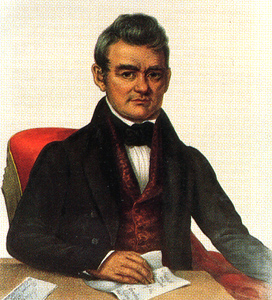
John Ross
John Ross, son of Daniel and Mollie McDonald Ross, was born in the fall of 1790 in present-day Cherokee County, Alabama. At the age of seven, the Ross family settled in southern Tennessee near the northern end of Lookout Mountain. As an adult, Ross moved a few miles to the south and settled at the home of his maternal grandfather, John McDonald, in Rossville, Georgia. The log cabin where he resided is preserved today as the Chief John Ross house.
Ross was well educated, having attended schools in Kingston and Maryville. In 1812 Ross received a government commission and traveled among the Cherokees who had accepted government relocation along the Arkansas River. Upon his return, Ross joined with U.S. agent Return J. Meigs in persuading the Cherokees to align with the United States government in the conflict with the Creeks.
In 1813 Ross joined Agent Meigs’s son, Timothy, in forming “Meigs and Ross.” This enterprise thrived by negotiating contracts with the United States government to supply goods to the Cherokees during the Creek War. After Timothy Meigs’s death, Ross’s brother Lewis joined the business. Firmly established along the southern bank of the Tennessee River, the Rosses’ warehouse became an important supply source for Indians and settlers. The settlement that grew around the river landing and warehouse became known as Ross’s Landing. In 1838 the area was incorporated under a new name, Chattanooga.
Though only one-eighth Cherokee, Ross’s ability to speak the Cherokee language fluently along with his early work with the U.S. government propelled him into a leadership role among the Cherokees. Elected a delegate to the Cherokee National Council in 1817, Ross was present at the council meeting in which government officials demanded Cherokee cession of land north of the Hiwassee River. Despite protests from Ross and several Cherokee chiefs, the land was ceded. Ross’s formal protest to the treaty stated that all the Cherokees wanted was to remain on their fathers’ land and to become a civilized people.
Using the United States Constitution as a model, Ross developed the Cherokee constitution in 1827. The following year Ross was elected principal chief of the Cherokees. As gold was discovered in its northern mountains, Georgia annexed all Cherokee lands within the state. Ross moved his family to the tribal council grounds at Red Clay, Tennessee, and made many trips to Washington, D.C., attempting to have Georgia’s action annulled. While Ross was appealing to Congress, a “Treaty Party” within the Cherokee nation signed an agreement that all Cherokees would move to land west of the Mississippi River for four and a half million dollars. In 1835 the national council repudiated the treaty and Chief Ross traveled to Washington with a petition of protest.
In early 1838 removal of the Cherokees began; the treatment was so bad throughout the first months that Chief Ross secured permission for the national council to oversee the removal of the Cherokees. That fall, seventeen thousand Cherokees led by Ross began their journey west. Four thousand perished along the way on the infamous Trail of Tears.
Reelected as Principal Chief, Ross traveled regularly to Washington on behalf of the Cherokee nation. In 1866 while on a trip east, Ross died in Philadelphia. His body was taken back to Oklahoma and buried at Park Hill cemetery near Tahlequah.



